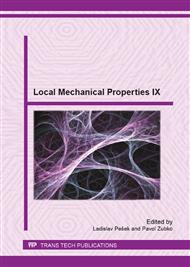p.39
p.43
p.47
p.51
p.55
p.59
p.63
p.67
p.72
Nanoindentation Applied to Materials with an Inner Structure
Abstract:
Nowadays, nanoindentation is commonly applied to various materials to assess micromechanical properties. Often, exact microstructure of the material building blocks is not properly analyzed which may introduce large discrepancies in the data obtained from different tests. It is shown in the paper, that different deformation mechanisms in tension and compression take place for the tested materials which is demonstrated by large differences between the measured nanoindentation moduli and macroscopic tensile elastic moduli. The situation is illustrated on several types of biological and man-made fibers. Differences ~44-57% in elastic moduli evaluated from the two tests appear in case of biological fibers, ~68% difference was found for high strength PVA fibers and 767% (!) for carbon fibers.
Info:
Periodical:
Pages:
55-58
Citation:
Online since:
September 2013
Authors:
Keywords:
Price:
Сopyright:
© 2014 Trans Tech Publications Ltd. All Rights Reserved
Share:
Citation:


